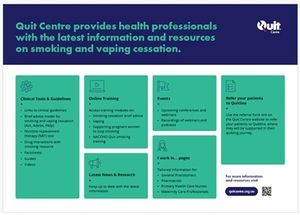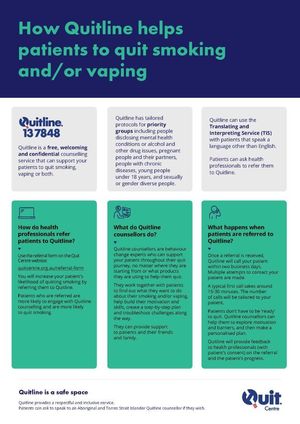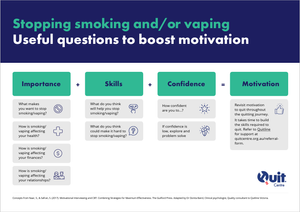38 results

Infographic - all about Quit Centre
This infographic explains Quit Centre. Read all about how we provide the latest information and resources for health professionals supporting their patients on smoking and vaping cessation.
News
Quit Centre Quarterly Newsletter - April 2025
Read our autumn edition of Quit Centre Quarterly
Newsletter
New infographic - How Quitline helps patients to stop smoking and/or vaping
Quitline is a free, confidential and welcoming counselling service that can support your patients to quit smoking, vaping or both. This infographic explains Quitline: how to refer your patients, the role of Quitline counsellors, and the process for patients once you've made the referral.
NewsEncourage patients who smoke to quit, during flu season
People who smoke are five times more likely to develop seasonal influenza than those who don’t. The risk of developing severe respiratory infections and complications related to influenza is also increased in this cohort. The onset of the flu season is a great opportunity to encourage all people who smoke to quit.
ResearchCochrane Review: Interventions for stopping vaping
Cochrane reviews are considered the gold standard in evidence and are used by clinicians and policymakers worldwide. The first Cochrane review about interventions for vaping cessation was published recently.
ResearchIntroducing Dr Cora Mayer, our new GP Lead
We welcome Dr Cora Mayer to the Quit Centre team. Cora is passionate about cancer prevention and supporting GPs to help their patients with smoking and vaping cessation.
NewsFor patients with COPD who smoke, it's never too late to quit.
A recently published comprehensive analysis revealed important benefits of smoking cessation in Chronic Pulmonary Obstructive Disease (COPD). It is never too late to quit, and smoking cessation care is a matter of priority for all patients with COPD who smoke.
News
New infographic on boosting your patient's motivation to stop smoking and/or vaping
This infographic provides some questions that can be used by health professionals to support patients to explore ambivalence and boost motivation to stop smoking, vaping or both.
News